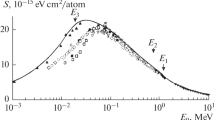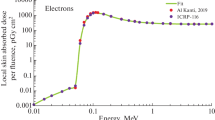Abstract
Absorbed dose and stopping power of the target material are two important parameters for determining the radiation effects. In this work, the relationship between these two parameters has been investigated for electron beams incident on skin and muscle tissue. Absorbed dose was obtained by using the EGSnrc code and the stopping power values were calculated by considering the velocity-depended effective charge and mean excitation values. To obtain the relationship between absorbed dose and stopping power values, these parameters were graphed together and simple fitting functions have been obtained. The results obtained show that these parameters are linearly correlated with each other.





Similar content being viewed by others
References
Akar A, Gümüş H (2005) Electron stopping power in biological compounds for low and intermediate energies with the generalized oscillator strength (GOS) model. Radiat Phys Chem 73(4):196–203
Andreo P (1991) Monte Carlo techniques in medical radiation physics. Phys Med Biol 36(7):861
Attix FH (1986) Introduction to radiological physics and radiation dosimetry. John Wiley & Sons, New York
Bethe H (1930) Zur theorie des durchgangs schneller korpuskularstrahlen durch materie. Ann Phys 397(3):325–400
Björk P, Knöös T, Nilsson P (2002) Influence of initial electron beam characteristics on Monte Carlo calculated absorbed dose distributions for linear accelerator electron beams. Phys Med Biol 47(22):4019
Bloch F (1933) Zur bremsung rasch bewegter teilchen beim durchgang durch materie. Ann Phys 408(3):285–320
Bohr N (1913) II. On the theory of the decrease of velocity of moving electrified particles on passing through matter. The London, Edinburgh, and Dublin Philosophical Magazine and Journal of Science 25(145):10–31
Bunge CF, Barrientos JA, Bunge AV (1993) Roothaan-Hartree-Fock ground-state atomic wave functions: Slater-type orbital expansions and expectation values for Z= 2–54. At Data Nucl Data Tables 53(1):113–162
Burlin T, Sidwell J, Wheatley B (1973) Applications of Monte Carlo methods in medical radiology. Br J Radiol 46(545):398–399
Clementi E, Roetti C (1974) Roothaan-Hartree-Fock atomic wavefunctions: basis functions and their coefficients for ground and certain excited states of neutral and ionized atoms, Z≤ 54. At Data Nucl Data Tables 14(3–4):177–478
Correa AA (2018) Calculating electronic stopping power in materials from first principles. Comput Mater Sci 150:291–303
Cygler J, Li XA, Ding GX, Lawrence E (1997) Practical approach to electron beam dosimetry at extended SSD. Phys Med Biol 42(8):1505
Das IJ, McGee KP, Cheng CW (1995) Electron-beam characteristics at extended treatment distances. Med Phys 22(10):1667–1674
Firsov O (1959) A qualitative interpretation of the mean electron excitation energy in atomic collisions. Zhur Eksptl' i Teoret Fiz 9:1076
Ford R, Nelson W (1978) The EGS code system—version 3 Report SLAC-210. Stanford Linear Accelerator Center, Stanford
Gümüş H, Kabadayı Ö, Tufan MÇ (2006) Calculation of the stopping power for intermediate energy positrons. Chin J Phys 44(4):290–296
Hogstrom KR, Almond PR (2006) Review of electron beam therapy physics. Phys Med Biol 51(13):R455
ICRU I (1989) Tissue substitutes in radiation dosimetry and measurement. International Commission on Radiation Units and Measurements
Kapur A, Ma C-M (1999) Stopping-power ratios for clinical electron beams from a scatter-foil linear accelerator. Phys Med Biol 44(9):2321
Katagiri M, Hikoji M, Kitaichi M, Sawamura S, Aoki Y (2000) Effective doses and organ doses per unit fluence calculated for monoenergetic 0.1 MeV to 100 MeV electrons by the MIRD-5 phantom. Radiat Prot Dosimetry 90(4):393–401
Khan FM, Gibbons JP (2014) Khan’s the physics of radiation therapy. Lippincott Williams & Wilkins, Philadelphia
Kirkwood B, Sterne J (2003) Bootstrapping. medical statistics. Blackwell Science, Oxford
Licona I, Figueroa-Medina E, Gamboa-deBuen I (2017) Dose distributions and percentage depth dose measurements for a total skin electron therapy. Radiat Meas 106:365–372
Lindhard J, Scharff M (1961) Energy dissipation by ions in the keV region. Phys Rev 124(1):128
Love P, Lewis D, Al-Affan I, Smith C (1998) Comparison of EGS4 and MCNP Monte Carlo codes when calculating radiotherapy depth doses. Phys Med Biol 43(5):1351
Ma C-M, Jiang SB (1999) Monte Carlo modelling of electron beams from medical accelerators. Phys Med Biol 44(12):R157
Mihailescu D, Borcia C (2018) electron dose distributions in inhomogeneous phantoms: a Monte Carlo Study. Rom Rep Phys 70:603
Mohan R, Chui C, Lidofsky L (1985) Energy and angular distributions of photons from medical linear accelerators. Med Phys 12(5):592–597
Podgorsak EB (2005) Radiation oncology physics. International Atomic Energy Agency, Vienna, pp 123–271
Rogers D (2006) Fifty years of Monte Carlo simulations for medical physics. Phys Med Biol 51(13):R287
Rogers D, Kawrakow I, Seuntjens J, Walters B, Mainegra-Hing E (2003) NRC user codes for EGSnrc. NRCC Report PIRS-702 (Rev. B)
Rohrlich F, Carlson B (1954) Positron-electron differences in energy loss and multiple scattering. Phys Rev 93(1):38
Saadi MK, Machrafi R (2020) Development of a new code for stopping power and CSDA range calculation of incident charged particles, part A: electron and positron. Appl Radiat Isot 161:109145
Sánchez-Doblado F, Andreo P, Capote R, Leal A, Perucha M, Arráns R, Carrasco E (2003) Ionization chamber dosimetry of small photon fields: a Monte Carlo study on stopping-power ratios for radiosurgery and IMRT beams. Phys Med Biol 48(14):2081
Saw CB, Pawlicki T, Korb LJ, Wu A (1994) Effects of extended SSD on electron-beam depth-dose curves. Med Dosim 19(2):77–81
Şengül K, Çetintaş SK, Gözcü S, Şahin S, Meral K, Demiröz C, Özkan L (2011) Elektron Işınlarının Farklı Kaynak-Yüzey Mesafelerinde Dozimetrik Olarak İncelenmesi. Uludağ Üniversitesi Tıp Fakültesi Dergisi 37(1):17–20
Sugiyama H (1985) Stopping power formula for intermediate energy electrons. Phys Med Biol 30(4):331
Trujillo-López L, Cabrera-Trujillo R (2019) Electronic stopping cross section for protons incident on biological and biomedical materials within a FSGO quantum chemistry description. Radiat Phys Chem 156:150–158
Tufan MÇ, Namdar T, Gümüş H (2013) Stopping power and CSDA range calculations for incident electrons and positrons in breast and brain tissues. Radiat Environ Biophys 52(2):245–253
Usta M, Aydın G (2020) Use of Gaussian-type functions for flux-based dose calculations in carbon ion therapy. Radiat Environ Biophys 59(3):511–522
Usta M, Tufan MÇ (2017) Stopping power and range calculations in human tissues by using the Hartree-Fock-Roothaan wave functions. Radiat Phys Chem 140:43–50
Vandana S, Benny P, Selvam TP (2018) Comparison of measured and Monte Carlo-calculated electron depth dose distributions in aluminium. NISCAIR-CSIR, India
Weber WJ, Zhang Y (2019) Predicting damage production in monoatomic and multi-elemental targets using stopping and range of ions in matter code: challenges and recommendations. Curr Opin Solid State Mater Sci 23(4):100757
Yani S, Lestari FP, Haryanto F (2018) Could water replace muscle tissue used in electron and photon beams? A Monte Carlo Study. Paper presented at the 2018 2nd International Conference on Biomedical Engineering (IBIOMED). IEEE. https://doi.org/10.1109/IBIOMED.2018.8534894
Yüksel Z, Tufan MÇ (2018a) Estimating the effect of electron beam interactions with biological tissues. Can J Phys 96(12):1338–1348
Yüksel Z, Tufan MÇ (2018b) Estimating the effect of electron beams ınteractions with the biological tissues. Can J Phys. https://doi.org/10.1139/cjp-2018-0093
Author information
Authors and Affiliations
Corresponding author
Ethics declarations
Conflict of interest
The authors declare that they have no conflict of interest.
Additional information
Publisher's Note
Springer Nature remains neutral with regard to jurisdictional claims in published maps and institutional affiliations.
Rights and permissions
About this article
Cite this article
Yüksel, Z., Tufan, M.Ç. Relationship between dose and stopping power values for electrons in skin and muscle tissues. Radiat Environ Biophys 60, 135–140 (2021). https://doi.org/10.1007/s00411-020-00888-1
Received:
Accepted:
Published:
Issue Date:
DOI: https://doi.org/10.1007/s00411-020-00888-1




